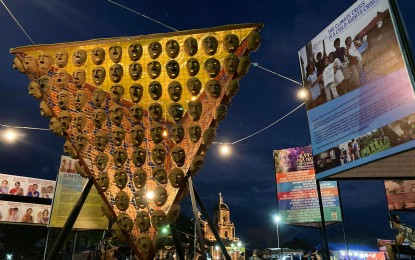
'FACES' OF CLIMATE CHANGE. An art exhibit of terracotta masks is ongoing at the town plaza of Lambunao, Iloilo. The exhibit, which features 220 clay face masks prepared by potters from the municipality of Lambunao, presents the various effects of climate change. (PNA photo courtesy of Raz Salvarita)
ILOILO CITY – An Ilonggo artist is leading the advocacy to raise awareness of the impact of climate change, through a terracotta mask exhibit at the town plaza of Lambunao, Iloilo.
Raz Salvarita, co-founder of the group Baryo Balangaw Creative Initiatives which is focused on “bridging creativity in rural communities”, said the initiative is part of the program of the International Teaching Artist Collaborative (ITAC) based in the United Kingdom.
He was one of five artists who received a grant from ITAC to work on the effects of climate change.
The four others came from Australia, Brazil, South Africa, and Serbia.
“The target is climate change but using art as a tool in engaging behavioral change and campaigning for climate education. Thus, this exhibit,” he said in an interview on Saturday.
A total of 220 terracotta masks were crafted by potters from Barangay Binaba-an Tirador, also in Lambunao.
“These are faces (of) people expressing their anxiety, sorrow. Most of the faces are sad faces because they represent people’s suffering from calamities,” he said.
Anchored on the theme “Unmasking Climate Injustices, Voices from the Past, Present and Emerging Generation”, Salvarita said the masks are mounted on an inverted pyramid to send a message on the need to change the system and support climate change actions.
The exhibit, which had its soft opening in the town plaza on December 22, is a gradual campaign to show that some communities are responsive to problems happening around them, he added.
The exhibit, which runs until February next year, was launched in partnership with the local government unit of Lambunao through the municipal tourism office, I Love Lambunao Volunteer Team, and the Supreme Student Council of the Lambunao National High School.
Salvarita said the preparation of clay masks was well-documented, from the sourcing of their raw materials up to the baking of the clay.
While working on the project, they were also oriented about climate change, its related terminologies, and the carbon footprint or the carbon dioxide that they produced while preparing the masks.
“Overall, the project has consumed almost 1.35 tons of carbons. So, we have plans to initially plant 65 seedlings to compensate for our work,” he said.
“Hopefully, it can leave an impact, especially with those who visit to view it mostly at nighttime and start a conversation. The challenge with the climate change talk is either it’s too scientific or it is something that others see as normal.” (PNA)
